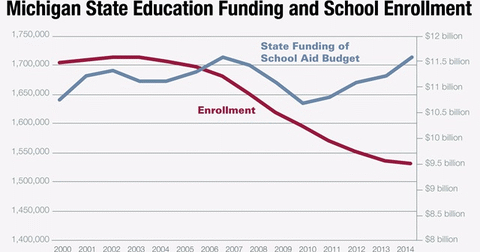Poll Shows Many Michigan Residents Misinformed About Education Spending
A significant number of Michigan residents are wrong about school spending under Gov. Rick Snyder, according to the results from a recent poll.
The issue is important because Democrat Mark Schauer has made education spending a key piece of his campaign for governor and repeatedly has erroneously said Gov. Snyder has cut education spending by $1 billion.
State funding for K-12 education has increased since Gov. Snyder took office.
Nonetheless, a March 14 poll reported that 53.8 percent of respondents said they thought Gov. Snyder had decreased spending, while 18 percent said they thought the governor had increased spending.
The survey, which was done by Denno Research and was paid for by Lambert, Edwards & Associates, asked this question: "In the three years that Governor Rick Snyder has been in office, do you think he overall has increased or decreased spending for K-12 schools?"
The poll questioned 233 Democrats, 145 Independents and 189 Republicans and another 33 people who were unsure of their political affiliation.
According to the Senate Fiscal Agency, overall state funding for K-12 education has increased every year under Gov. Snyder. That includes his first budget when he allocated more state money for K-12 education than former Gov. Jennifer Granholm.
State funding for K-12 education was at $10.8 billion in Gov. Granholm's last budget in 2010-11. State funding jumped to $11.08 billion in Gov. Snyder's first budget in 2011-12 and then increased to $11.21 billion in 2012-13 and $11.6 billion in 2013-14.
Yet Schauer, the Michigan Education Association and some others have been claiming that Gov. Snyder cut funding to public education, which the Detroit Free Press said was not accurate.
In January, Schauer erroneously claimed on WJR radio that an increase in funding to K-12 schools under Gov. Snyder was due to more federal dollars.
Federal dollars have dropped from $2.17 billion in Gov. Granholm’s last budget in 2010-11 to $1.65 billion in Gov. Snyder’s first budget and then increased to $1.7 billion and $1.76 billion the next two years.
Since then, critics of Gov. Snyder have shifted their debate to whether the extra money Gov. Snyder was allocating for K-12 schools was "getting into the classroom."
The state spent $564 million in 2012-13 and 2013-14 to cover the school employees' retirement costs in the Michigan Public School Employees Retirement System. Many Democrats don't believe paying teachers' benefits is a classroom expense.
Still, the perception among residents, according to the poll, is that K-12 school funding has been reduced.
"Politicians like Mark Schauer keep repeating the false 'they cut schools' claim, probably betting their simplistic bumper sticker line could trump a truth that requires a full paragraph to convey," said Jack McHugh, senior legislative analyst for the Mackinac Center for Public Policy. "Meanwhile, the alleged budget cutters in the Snyder administration have not done all they could to get the facts out."
Sara Wurfel, a spokeswoman for Gov. Snyder, did not respond to a request for comment.
Michigan Capitol Confidential is the news source produced by the Mackinac Center for Public Policy. Michigan Capitol Confidential reports with a free-market news perspective.


.jpg) Michigan schools seek $1.6 billion in new public debt May 6
Michigan schools seek $1.6 billion in new public debt May 6
 Michigan spends $6.9M advertising 'cost-free' pre-K
Michigan spends $6.9M advertising 'cost-free' pre-K
 School survey asks high schoolers about sex, drug habits
School survey asks high schoolers about sex, drug habits
Michigan's Film Incentive Program Has Been A Bust
Taxpayers have spent nearly $450 million with little to show for it
In 2011, Michigan changed its open-ended film incentive program to a capped $25 million annual subsidy. Since then, it’s been increased to $50 million. While the executive budget this year calls for another $25 million for this program, it should be eliminated entirely.
All told, the state has devoted $444.7 million to film productions from both the tax credits and appropriations, according to the state treasury and budget offices.
Despite spending hundreds of millions of dollars, the program is not designed to establish a permanent film industry. Approved film productions spend money in the state and leave. The state sends them a check based on what they spent. The hope is that if you keep priming the pump enough, someone will stay of their own goodwill.
That is unlikely to occur because other states — and even the agglomeration of film producers in California — also are offering their own incentives. Producers threaten to leave states that think about pulling back on incentives.
This is borne out by the economic reports on the film industry in Michigan. While the industry is not large enough to get monthly reports from the Quarterly Census of Employment and Wages, the survey lists 1,768 people employed by "motion picture and video production firms," in 2012. That is 0.05 percent of the total employment covered by the survey.
Total employment also is down from 2011 when 2,129 people were employed in this industry, though at no point from 2001 to 2012 were fewer than 1,300 or more than 2,200 people employed in this industry.
Supporters contend that film producers tend to use employee leasing agencies to hire workers. But that's the point — despite this substantial investment of taxpayer resources, there is no permanent film industry in Michigan. The state has so far approved $444.7 million in incentives with little to show for it.
Michigan Capitol Confidential is the news source produced by the Mackinac Center for Public Policy. Michigan Capitol Confidential reports with a free-market news perspective.
Follow us on social media!
Push back on big government “solutions” by becominga fan of us on Facebook and X. Plus you can share free-market news to your network!
Facebook
I already follow CapCon!
More From CapCon